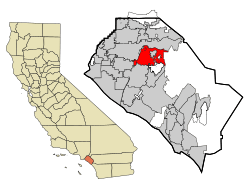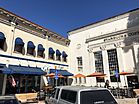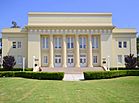Orange, California facts for kids
Quick facts for kids
Orange, California
|
|||
|---|---|---|---|
|
Clockwise from top: Orange Historic District; Memorial Hall; Chapman University; The Bill Holmes Tower at CHOC Main Campus; Plaza Park.
|
|||
|
|||
| Motto(s):
A Slice of Old Towne Charm
|
|||

Location of Orange within Orange County, California
|
|||
| Country | United States | ||
| State | California | ||
| County | Orange | ||
| Founded | 1869 | ||
| Incorporated | April 6, 1888 | ||
| Government | |||
| • Type | Council–Manager | ||
| Area | |||
| • Total | 25.81 sq mi (66.86 km2) | ||
| • Land | 25.66 sq mi (66.47 km2) | ||
| • Water | 0.15 sq mi (0.39 km2) 1.75% | ||
| Elevation | 190 ft (58 m) | ||
| Population
(2020)
|
|||
| • Total | 139,911 | ||
| • Rank | 7th in Orange County 43rd in California 196th in the United States |
||
| • Density | 5,452.49/sq mi (2,104.87/km2) | ||
| Time zone | UTC−08:00 (Pacific) | ||
| • Summer (DST) | UTC−07:00 (PDT) | ||
| ZIP Codes |
92856–92869
|
||
| Area codes | 657/714 | ||
| FIPS code | 06-53980 | ||
| GNIS feature IDs | 1652765, 2411325 | ||
Orange is a city in northern Orange County, California, United States. It is about 3 miles (4.8 km) north of Santa Ana, which is the main city of the county.
What makes Orange special is its Old Town District. Many houses there were built before 1920. While other cities tore down old homes in the 1960s, Orange chose to save them. The small city of Villa Park is completely surrounded by Orange. In 2020, Orange had a population of 139,911 people.
Contents
- History of Orange, California
- Geography and Climate of Orange
- City Landmarks and Districts
- Population and People of Orange
- Economy and Jobs in Orange
- Fun Things to Do in Orange
- Sports and Recreation
- Education in Orange
- Getting Around Orange
- Famous People from Orange
- Sister Cities
- Images for kids
- See also
History of Orange, California
Early History and Spanish Influence
Long ago, the Tongva and Juaneño/Luiseño people lived in this area. In 1769, an expedition led by Father Junípero Serra named the area Vallejo de Santa Ana (Valley of Saint Anne). The first lasting European settlement was Mission San Juan Capistrano, built in 1776.
In 1801, the Spanish Empire gave 62,500 acres (253 km²) of land to José Antonio Yorba. He called it Rancho San Antonio. This huge ranch included land where many cities like Orange, Santa Ana, and Newport Beach are today. Smaller ranches later grew from this big one.
Don Juan Pablo Grijalva, a retired Spanish soldier, was the first landowner in the area. In 1809, he got permission to start a ranch near the Santiago Creek.
Becoming Part of the United States
After the Mexican–American War, California became part of the United States in 1848. Even though many Mexican landowners lost their land, Grijalva's family kept theirs by marrying American settlers.
By 1864, lawyers Alfred Chapman and Andrew Glassell owned about 5,400 acres (22 km²) along the Santiago Creek. They chose this spot for a town because they could bring water from the Santa Ana Canyon to irrigate the land.
Founding the City of Orange
The community was first named Richland. But in 1873, it needed a post office. The name "Richland" was already taken in California. So, the people chose a new name: Orange.
The town officially became a city on April 6, 1888. Orange is special because it was the only city in Orange County planned and built around a central plaza. This is why it's sometimes called Plaza City. It was also the first town in the county to get train service from the California Southern Railroad.
Growth and Development
Orange grew quickly in the late 1800s. This was because more and more people wanted citrus fruits grown in California. This time was even called the "Orange Era." The city's population also grew when many people moved to Southern California between 1886 and 1888.
Like most cities in Orange County, farming was very important to Orange's economy. Growth was slow until the 1950s. Then, new freeways connected Orange to Los Angeles, leading to a lot of new homes being built. This building continued into the 1970s and still happens today, but more slowly.
During the COVID-19 pandemic, the city closed some streets in the downtown area. This allowed businesses to have outdoor seating and patios, helping people stay safe. The city council voted to keep these streets closed for a longer time.
Geography and Climate of Orange
City Area and Water
The city of Orange covers about 25.2 square miles (65.3 km²). Most of this is land (24.8 sq mi or 64.2 km²), and a small part is water (0.4 sq mi or 1.0 km²). About 1.75% of the total area is water.
Weather in Orange
Southern California is known for its pleasant weather all year.
- The warmest month is usually August.
- The highest temperature ever recorded was 113°F (45°C) in June 2016.
- The coolest month is usually December.
- The lowest temperature ever recorded was 25°F (-4°C) in December 1990.
- Most rain falls in January.
From April to November, the weather is warm and dry. High temperatures are usually between 74°F and 84°F (23°C and 29°C). Lows are between 52°F and 64°F (11°C and 18°C). From November to March, it's a bit rainier.
Orange County has something called a "microclimate." This means temperatures can change a lot over short distances. For example, it can be 18°F (10°C) warmer inland than at the coast. Sometimes in late spring and early summer, there's "June Gloom" or "May Gray." This means it's cloudy or foggy in the morning, but usually clears up by noon.
Orange County gets about 15 inches (380 mm) of rain each year. Most of this rain happens in winter and spring (November to April). It's usually light rain, but sometimes there are heavy downpours and thunderstorms. Snow is very rare in the city itself, but the nearby mountains get snow every winter.
City Landmarks and Districts
Old Towne, Orange Historic District
The Old Towne, Orange Historic District is a special area about one square mile around the original city plaza. It has many of the first buildings built after Orange became a city. This area is a busy place with shops and restaurants. It also has Orange County's oldest bank that is still open.
The Historic District was added to the National Register of Historic Places in 1997. It is the largest historic district in California listed on the National Register. The Old Towne Preservation Association is a group that works to keep the district looking good.
Orange is unique because it has the second largest number of historic buildings in the region and state. The Civic Center building was designed by Welton Becket in 1963.
Even though Orange is a developed city, some parts of the land inside the city limits are not yet officially part of the city. These include areas like El Modena, North El Modena, Orange Park Acres, and Olive.
Population and People of Orange
How Many People Live Here?
The city of Orange has grown a lot over the years. In 1880, there were only 679 people. By 2020, the population had grown to 139,911.
Who Lives in Orange?
According to the 2020 Census, Orange is a diverse city.
- About 39.55% of people are White (not Hispanic).
- About 12.91% are Asian.
- About 1.59% are Black or African American.
- About 41.15% of the population is Hispanic or Latino (who can be of any race).
In 2010, there were 43,367 households in Orange. About 37.6% of these households had children under 18. The average household had 3 people. The median age in Orange was 34.8 years old.
In 2009-2013, the average income for a household in Orange was $78,838. About 11.8% of the people lived below the poverty line.
Economy and Jobs in Orange
Top Employers in the City
Many people work in Orange. Here are some of the biggest employers in the city as of 2023:
| # | Employer | # of employees |
|---|---|---|
| 1 | University of California, Irvine Medical Center | 4,995 |
| 2 | Children's Hospital of Orange County | 3,938 |
| 3 | Sisters of St. Joseph Hospital | 3,500 |
| 4 | Chapman University | 1,300 |
| 5 | Santiago Canyon College | 950 |
| 6 | CalOptima Health Plans | 930 |
| 7 | City of Orange | 800 |
| 8 | Chapman Integrated Healthcare Holdings | 700 |
| 9 | Orange County Transportation Authority | 500 |
| 10 | Hilton Hotel Fera | 477 |
Fun Things to Do in Orange

Local Attractions
- Orange International Street Fair: This big event happens every year on Labor Day Weekend in Downtown Orange. It started in 1973 and attracts about 400,000 visitors each year!
- Orange County Zoo: You can visit the zoo, which is located in Orange at Irvine Regional Park.
- Shopping: There are several places to shop, including The Village at Orange and The Outlets at Orange. The Outlets is an outdoor shopping and entertainment center with a skatepark and bowling alley.
- Woman's Club of Orange: This club, started in 1915, holds an annual flower show. Their clubhouse, built in 1923–1924, is a historic site.
- Villa Park Orchards Association: This is the only fruit packing house left in Orange County. It's located along the old train line.
- Lewis Ainsworth House: This is a restored house that is now a museum.
Building Styles in Old Towne Orange
When you walk around Old Towne Orange, you can see many different styles of old buildings. Some of these include:
- Bungalow
- Craftsman Bungalow
- Arts and Crafts Movement
- Hip roof cottage
- Mediterranean Revival architecture
- Prairie Style architecture
- Spanish Colonial Revival architecture
- Victorian architecture
Sports and Recreation
Orange is close to major league sports teams. The Los Angeles Angels of Anaheim (baseball) and the Anaheim Ducks (ice hockey) play right across the Santa Ana River in Anaheim.
In Orange itself, the SoCal A's baseball team plays at Athletic (or Richland) Field.
Education in Orange
Public Schools
All public schools in Orange are part of the Orange Unified School District. This district serves about 28,000 students in Orange and nearby cities like Anaheim and Garden Grove. High schools in the district include Orange High School, Villa Park High School, El Modena High School, and Canyon High School.
Colleges and Universities
- Chapman University
- Santiago Canyon College
Other Schools
- International School of Los Angeles
- Eldorado Emerson Private School (for preschool through high school)
- Lutheran High School of Orange County
Getting Around Orange
Roads and Freeways
Orange is located near major freeways, making it easy to travel. Interstate 5, also known as the Santa Ana Freeway, passes through the city.
The ""Orange Crush"" is a very busy highway intersection on the southwest side of Orange. It connects I-5 with SR 57 (the "Orange Freeway") and SR 22 (the "Garden Grove Freeway"). The Costa Mesa Freeway (SR 55) also goes through Orange.
The eastern parts of Orange are served by toll roads, SR 261 and SR 241. These roads connect Orange to cities like Irvine.
Train Service
Orange had its first train service in 1886. It was a horse-drawn streetcar line between Santa Ana and Orange. Later, it became an electric train line.
The Santa Fe Railway laid its tracks through Orange in 1886. By 1925, 16 passenger trains stopped in Orange every day. During busy farming seasons, up to 48 train cars of citrus fruits, olives, and walnuts were shipped daily from Orange.
Orange's old Santa Fe train station, built in 1938, is still standing. It's next to the modern Orange Transportation Center. The old building is now a restaurant.
Today, you can take Metrolink commuter trains from the Orange Transportation Center. These trains connect Orange to Los Angeles, the Inland Empire, and Northern San Diego County. It's the second busiest station in the Metrolink system because it's a transfer point for different train lines.
Air Travel
John Wayne Airport (SNA) is in nearby Santa Ana. It offers daily flights for the area.
Emergency Services
- Police: The Orange Police Department (OPD) keeps the city safe. They have different teams for patrols, traffic, investigations, and more. They also have a special SWAT team.
- Fire: The Orange City Fire Department has eight fire stations. They have fire engines, trucks, and rescue ambulances. Firefighters are also trained as emergency medical technicians to help with medical emergencies.
Famous People from Orange
Many notable people have connections to Orange, California:
- Don Aase, born in Orange, a professional baseball player.
- Héctor Ambriz, a professional baseball player.
- Garrett Atkins, a professional baseball player.
- Shane Bieber, a professional baseball player and Cy Young winner.
- Jeff Buckley, a famous singer-songwriter.
- Lauren Chamberlain, a professional softball player, born in Orange.
- Mikey Day, a comedian and writer for Saturday Night Live, born in Orange.
- Zach Ertz, a professional football player, born in Orange.
- David Fletcher, a professional baseball player.
- Ciara Hanna, an actress known for martial arts roles, born in Orange.
- Steve Johnson, a professional tennis player.
- Dean Koontz, a novelist who used to live in Orange Hills.
- Mike Pompeo, a former US Secretary of State and CIA Director.
- Sunny, a Korean-American K-pop singer from the group Girls' Generation.
- Ginger Zee, a meteorologist for ABC News and Good Morning America, born in Orange.
Sister Cities
Orange has "sister city" relationships with cities around the world. These partnerships help people from different countries learn about each other's cultures.
 Novo Kosino, Moscow, Russia
Novo Kosino, Moscow, Russia Orange, New South Wales, Australia
Orange, New South Wales, Australia Orange, Vaucluse, France
Orange, Vaucluse, France Santiago de Querétaro, Mexico
Santiago de Querétaro, Mexico Timaru, New Zealand
Timaru, New Zealand
Orange used to have partnerships with Utrecht, the Netherlands, and Santiago, Chile.
Images for kids
See also
 In Spanish: Orange (California) para niños
In Spanish: Orange (California) para niños





















